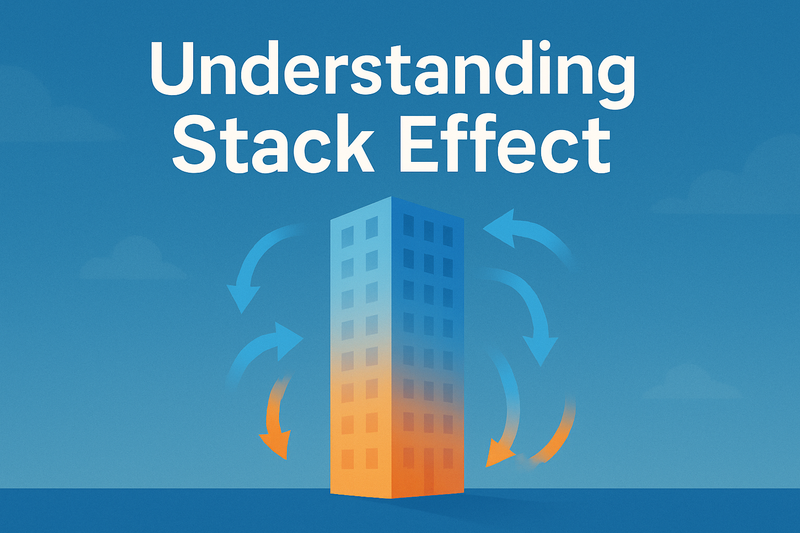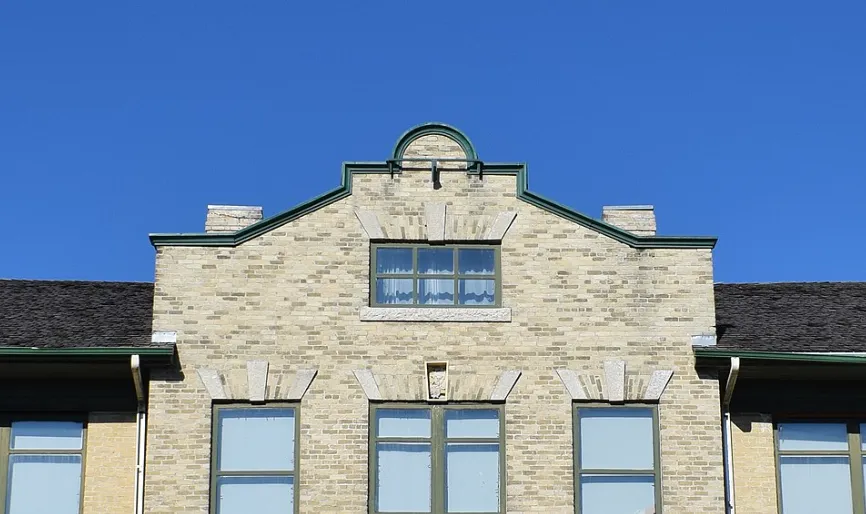
Stack effect is a phenomenon found in tall buildings where excessive infiltration and exfiltration are experienced, particularly at the top and bottom floors, and are caused by the difference in buoyancy between warm and cold air. Stack effect can create large pressure differentials between outside and inside environments in tall buildings, particularly when the temperature differential is large. A large pressure differential leads to large quantities of infiltration, as well as potential hazards of doors not opening properly and unpleasant air movement within the building.
Mitigating stack effect becomes increasingly important as building height increases, and can be achieved through both mechanical and architectural design considerations, as well as improved construction and material quality.
Stack effect is caused by a difference in buoyancy between warm and cold air. In buildings with tall, continuous vertical shafts such as stairwells, elevator shafts, duct chases, etc., allowing long distances of vertical air movement, warm air will naturally move to the top and cool air will move to the bottom. This results in a significant difference in temperature between top and bottom of the vertical space, and therefore a difference in density of air between top and bottom. This difference in density results in a difference in the outdoor-indoor pressure differential between top and bottom floors, with the warmer air wanting to push its way into the colder space due to the higher temperature (and therefore pressure) of the warmer air.
This means that if the outdoor air is colder than the indoor air, the air will exfiltrate at the top of the building and infiltrate at the bottom. If the outdoor air is warmer than the indoor air, the opposite will occur and air will exfiltrate at the bottom floors and infiltrate at the top. Even though in winter the air is warmer indoors than outdoors at both the top and bottom, the top floors will have the larger temperature differential compared to the outdoor temperature, and therefore the exfiltration force will be stronger than at the bottom. Since the air pushes harder to exfiltrate at the top, it must infiltrate at the bottom.
Larger uninterrupted vertical distances in buildings will cause a stronger stack effect. Although it is only dependent on the vertical shafts, the infiltration and exfiltration will have an impact on the conditioned space after getting through the buffer of the stairwell or elevator doors. This happens in both summer and winter, but typically winter is considered a bigger issue since the indoor to outdoor temperature differential is larger causing a stronger stack effect, and winter infiltration has a much bigger impact on equipment sizing due to the quick and unpleasant effect of cold air infiltration.
Determining total infiltration based on pressure differential across the building envelope can be a complicated process involving stack effect, wind effect, building pressurization, and estimates of construction quality. However, components of stack effect can be computed with relatively few data points. Calculating infiltration from stack effect can be split into two components: Computing the pressure differential across the exterior walls Determining infiltration rate as a function of pressure differential
The pressure differential is typically estimated as a linear function of distance from the neutral pressure level (NPL). The NPL is the vertical location within the building shafts where the pressure differential is 0. This happens due to the fact that it is negative at one end and positive at the other end.
The NPL is rarely at the midpoint in the height of a building. If a building has horizontal separations in it, not allowing vertical shafts to continue from top to bottom, then it can have multiple NPLs, one for each continuous vertical section. An imbalance of openings between the lower and upper floors will also change the location of the NPL. It is common for buildings to have more doors on the bottom floor (especially doors that open frequently) than the top, which will pull the NPL downward, closer to the main floor.
A good procedure for calculating the pressure differential due to stack effect can be found in Chapter 4 of the ASHRAE 2023 Handbook: HVAC Applications. This involves crack area around external doors, internal shaft doors, elevator doors, temperature difference, and vertical position within the building.
Preventing or minimizing the effects can be categorized into mechanical decisions and architectural decisions. Both are important, and therefore for tall buildings stack effect should be discussed early in the design process to ensure any necessary architectural design decisions can be made before the building design has gone too far.
There are several ways that the strength of the stack effect can be reduced through architectural design features. One way is to use horizontal separations in vertical shafts. For example, in a 40-storey building, instead of having some elevators going all the way from the lobby to the top floor, elevator shafts could be split so that one elevator shaft goes from floor 1 to 20, and another from floor 21 to 40. This effectively splits the building into two 20-storey buildings, making the stack effect much easier to overcome than it would be if it were using the entire 40 storeys for air movement. In order to ensure this method would work, the same would need to be done in stairwells and any other vertical shafts.
The result would be a building with 2 NPLs instead of 1, meaning the maximum distance from each NPL will be significantly reduced.
The location that typically has the most openings and increases the severity of stack effect is the lobby. Lobbies can be designed with better door seals, vestibule doors, or revolving doors, allowing the building to keep its seal better at the main floor level.
Using mechanical pressurization of the building will allow for better control over how much ventilation comes into the building. However, caution must be exercised when pressurizing a building. Pressurization requires adding more outdoor air to the building than exhaust air being removed. If this is not actively measured and controlled as the building is operated, it can potentially cause excessive pressure differentials and result in doors being difficult to open or close, creating a fire safety hazard, as well as causing some exhaust fans or air movement equipment to underperform.
Another downside is the excessive energy usage by increasing outdoor air. Outdoor air heating in the winter and cooling/dehumidification in the summer can be a significant contributor to building energy usage, and increasing airflow only exacerbates the issue. Another risk is the potential for damaging the building envelope; in cold climates when a building is positively pressurized in the winter, humid indoor air will be pushed into the building materials and can then freeze as it gets through the insulation. As it freezes it expands, pushing building materials outwards and causing damage to the exterior materials. The image below shows a brick that has fallen out of a building due to freezing moisture in the building materials behind the masonry.
 This does not mean that building pressurization is a bad idea; it can be a very good thing to do and improve building performance, but must be designed and constructed with caution and all negative side effects should be thought through.
This does not mean that building pressurization is a bad idea; it can be a very good thing to do and improve building performance, but must be designed and constructed with caution and all negative side effects should be thought through.
An easier way of mitigating the negative effects of stack effect in the winter is adding excessive heat into the vestibule and lobby. This is a way of just accepting that stack effect will happen and mitigating the most noticeable impact of it.
Construction quality of the building will make a huge impact on the severity of the stack effect. Construction of walls, windows, exterior doors, interior doors, and elevators should be overseen closely to ensure all cracks are being sealed as per project specifications. If they aren’t, the calculations regarding the stack effect will be off, and building performance will not go as expected (another reason why pressurizing the building is risky).
If the building is not constructed with proper quality and expertise, additional infiltration will find its way through almost every crack, including between bricks.
Stack effect is not a trivial component of infiltration, and infiltration is not a trivial component of building heating and cooling loads. Stack effect is increased when the temperature difference is greater, making it more severe in winter, and especially in cold climate zones.
Failing to take into account the impacts of stack effect will likely result in larger loads in certain spaces, particularly the lower floors in the winter and the top floors in the summer. Differences in humidity can cause even further side effects when infiltration is higher than anticipated and must be addressed accordingly.
Stack effect can be reduced by a variety of architectural design features, or by mechanical pressurization. Pressurization is a good way of controlling the pressure differential across thie building and preventing infiltration, but caution must be used due to the number of potential side effects and unknowns regarding equipment and building envelope performance. In cold climates when buildings are not excessively tall, the easiest way to deal with the negative side effects of stack effect from a mechanical perspective is to add extra heat into the vestibule and lobby areas, as well as air curtains to separate the outdoor and indoor environments.